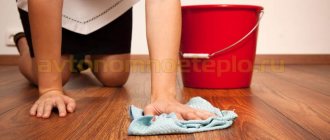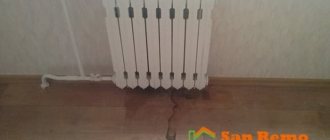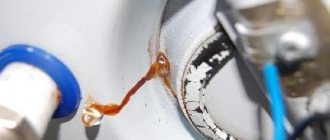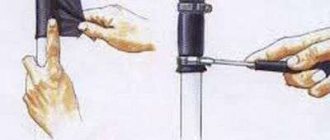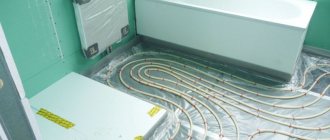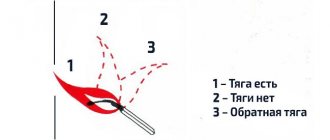Boilers ensure independence from public utilities, supplying people with water around the clock and at any time of the year. If the safety valve is dripping in the water heater, this circumstance should be considered objectively, without nerves or showing emotions. First of all, you need to understand that the faucet is designed for water to drip from it. The only question is how often this happens and what volumes of liquid leave the tank per unit of time. A calm analysis of this phenomenon will allow you to understand the nature of its origin and take effective measures to eliminate the malfunction.
Main functions of a safety valve
The safety valve protects the device from excess pressure and water hammer.
The first water heaters went on sale without components; the packaging of modern products always contains a safety valve. The instructions for installing and operating the tank state that operating the boiler without this part is strictly prohibited. The manufacturer indicates the location and method of attaching the valve. This recommendation is justified by the fact that tanks have a limited safety margin, and excessive internal pressure can simply rupture them. This situation is extremely dangerous for the life and health of people and can cause large-scale flooding of several apartments in a multi-story building.
Main functions of a check valve:
- Discharge of water from the tank when, when heated, it expands and begins to press on its walls with a force greater than that provided by the calculated data. Depending on the pressure level, water may run or drip at different rates.
- Compensation for water hammer. During such phenomena, the water pressure increases to values that are critical for domestic boilers. Thanks to a well-designed emergency mechanism, the faucet reduces the pressure by releasing liquid through a special pipe.
Most often, water drips from the boiler through the valve at night, when the volume of its consumption decreases significantly, but the pressure remains the same. The sound of falling drops may annoy household members, but this is not the worst thing. The main thing is that the emergency valves are working properly and people are not in danger. You can easily get rid of the noise - just tie a bandage, rope or long piece of fabric to the pipe and take it out into the bathtub, sink or toilet. Subsequently, the material should be replaced with an elastic drainage tube.
Principle of operation
If there is excess pressure, water is discharged into the sewer through the supplied pipe.
The check valve is a direct-acting safety pipeline fitting designed to protect water heating equipment from mechanical destruction under the influence of critical pressure. The principle of operation is to automatically adjust the water pressure inside the boiler. When it reaches the limit values, water is discharged. Release is carried out until the pressure reaches operating values.
The accuracy and functionality of the safety valve is determined by the parameters and settings of the internal parts.
Main tasks
A safety valve is required for several purposes:
- Dumping excess water from the tank. When the boiler is turned on to maximum heating mode, excess pressure is formed inside, which the safety valve must neutralize. Therefore, sometimes water flows from it.
- Compensation for water hammer. Although this is not a common occurrence in the water supply system, it can seriously damage the boiler tank;
- Leaks are recorded mainly at night. At this time, the intensity of water consumption is reduced to a minimum, and the pressure in the system remains at the same level. This is why the impact on the water heater tank increases significantly;
- The only drawback of nightly discharge of excess water is noise. It can be easily eliminated by putting a plastic tube on the faucet and leading it into the sewer hole.
Types and design of valves
According to their design, products are divided into monolithic and collapsible. The first are a monoblock, inside of which parts are pressed. The second option is equipped with a hole through which, after unscrewing the lid, access to the inside of the product is possible. The valves also differ in the way they drain drainage. Some have drops falling from a protruding pipe, others are equipped with a closed piping system with outlet to the sewer.
Structure of safety valves
General arrangement of safety valves:
- Frame. It has internal and external fastening threads and a side pipe. Made from steel or brass. Can be plated with nickel, chromium or zinc.
- Big cylinder. Located at the bottom of the body. Opens when opening the mixer and to fill the tank. It closes after the pressure inside the container and in the water supply system is equalized. Prevents water from flowing back into the supply pipe.
- Small cylinder. Located in the middle of the product, it is equipped with a more powerful spring. It contracts when the water pressure in the boiler or water supply exceeds the established norm. The drainage hole is released, through which the liquid flows out.
High-quality products from leading manufacturers have clear markings made using the molding method during the casting process. There are no visible seams or other defects. Branded parts are accompanied by a certificate of conformity. The price of such a product can reach up to 1000 rubles, but the safety is worth it.
What to do?
There may be several reasons for excessive water pouring out through the fitting of the valve device, and the solution to the problem can vary greatly in complexity and implementation technology:
- if an element loses its protective qualities due to wear, including spring stretching and cracking of the poppet device, the fittings are replaced;
- if the valve breaks down as a result of water hammer with a sharp increase in pressure in the water supply system, it is also advisable to replace the element with a new one with similar indicators;
- if the fitting or the internal part of the system is clogged with debris and scale, it is advisable to clean it, partially or completely replace it;
- if the leak is caused by initially incorrect installation of the protective unit, then it is necessary to carry out diagnostics of the safety valves, including measuring the relief pressure using a pressure gauge, followed by replacing the valve if necessary;
- if excessive leakage of water and incorrect operation of the fittings of the water heating device are caused by non-compliance with installation requirements, then the protective unit should be moved to the correct location.
After the correct relocation of the protective fittings or complete replacement of the safety assembly has been carried out, the excess flow of water should stop. The opposite effect is observed when the nominal pressure level declared by the manufacturer does not correspond to real indicators.
No less often, the cause of leakage is an incorrectly selected or too high temperature mode for heating water, as well as excess water pressure inside the system, so the purchased water heating equipment must fully comply with all requirements.
Correctly installed boiler
It is very important to remember that the operation of water heating equipment without accessories such as a safety valve device is strictly prohibited. When installing an alternative hot water supply system in conditions of excess pressure in the main water supply, a special reducer must be installed at the inlet, capable of regulating such parameters.
Do you want to save money on boiler installation? How to connect a water heater to the water supply in an apartment - you will find a connection diagram in the article.
We will consider types of plastic panels for the bathroom and repair options in this material.
A prerequisite for comfortable and safe operation of water heating equipment equipped with a safety valve device is the supply of a flexible transparent hose to the drainage hole, the second end of which is discharged into the sewer system or a container specially installed to collect the released water.
Valve installation and adjustment
The safety valve is mounted on the cold water pipe.
The check valve is attached to the cold water pipe. For ease of work, manufacturers mark it in blue. You can screw the tap on at any stage of installation, but it is more advisable to do this before hanging the tank on the hooks. When the heater is on the floor, working with it is much easier, more convenient and safer.
Installation should be done in the following sequence:
- Unscrew the mounting bolts and remove the plastic cover. To prevent it from interfering with your work, you do not need to remove the light bulb from it and then put it in a safe place.
- Inspect the threads on the inlet pipe of the tank, visually check its integrity. Clean the coils with a brush and remove transport grease with a dry cloth.
- Carry out a similar procedure with the upper union nut of the valve. If there are burrs, they must be carefully removed with a knife or file.
- Wrap tape around the FUM pipe. This should be done clockwise, moving the thickening towards the side. The layer thickness should be 1 mm at the cut and 3 mm at the beginning of the thread.
- Take the valve, catch the edge of the thread and start screwing it on. The product should go tightly and with effort. It is important that at the end of the rotation the nut does not rest against the side. This will mean that not enough FUM tape has been wound. The procedure will have to be repeated.
After fixing the safety valve, you can immediately attach the ball valve to it. The procedure is similar.
How to choose
When choosing a safety valve for a water heater, pay attention to the following components:
- the temperature for which it is designed;
- threaded connections (usually half an inch);
- pressure;
- Is there a handle for forced draining in the design?
When purchasing a relief valve, be sure to check its pressure, because... this is one of the most important indicators. If you buy a device with a smaller size, you will constantly have to deal with the problem of water leakage. If it is larger, then it may be useless and will not protect the container from explosion.
You will also need to install a water filter, which will protect the water heater.
Causes of safety valve failure
With constant high pressure, the spring inside weakens, the part needs to be replaced.
If the valve on the boiler drips constantly, regardless of the time of day and the intensity of water use in the house, there is a high probability that the product is faulty. There can be many reasons for this.
- Manufacturing defects. As a rule, these are weak springs and leaky cylinders. Such products will operate even under operating pressure. Those who are trying to save money and buy cheap Chinese counterfeits have to deal with such a nuisance.
- Blockage. Occurs when the tank is not cleaned properly or due to poor water quality. The essence of the breakdown is that after compression, the spring cannot expand, since solid particles form an obstacle in its path. With such a malfunction, the product will leak even when the device is turned off and the tap is closed.
- High system pressure. This is not uncommon on the top floors of high-rise buildings with overhead water supply. Since the pressure is maintained at a constantly high level, the valve will leak continuously, regardless of the time of day.
- Mechanical damage. Occurs during transportation or during installation. Internal parts can also be damaged during cleaning - deformation of the spring, rupture of gaskets. When dropped, a gap appears at the point where the pipe enters the boiler body.
- Storage tank leaking. In such cases, there is water on the outside of the product, but it may appear that the valve on the water heater is leaking. The cause of leakage is corrosion or a broken seam.
- The top part is leaking. There is a weak connection. This is one of the most common causes of dripping on the valve. In most cases, this occurs due to a hardened gasket under the nut or insufficient amount of FUM tape.
- Wear of springs. Over time, they lose their elasticity and begin to shrink even with slight pressure. Nothing will help here. All that remains is to install a temporary drain and go to the store for a new valve.
Once a leak has formed, it will not go away on its own. The situation will only get worse until it reaches a critical state. Therefore, if the safety valve on the boiler is leaking, it is necessary to take urgent measures to determine the causes of this phenomenon and restore the functionality of the water heater.
Self-diagnosis
You can check the serviceability of the safety unit yourself. To do this you need:
- Connect the boiler plug to the socket.
- Fill the storage tank.
- Shut off the water supply.
- Turn on the water heater using the start button.
- Wait until heating finishes.
- Check the condition of the valve.
You can conduct a self-diagnosis.
If water drips slowly from the drain, then the protective device is working properly. If not, or if the liquid flows in a stream, then most likely you will need to replace it or check the thermostat settings.
Repair work
To diagnose and fix the breakdown, you will need to stock up on a set of tools and some consumables.
To work you will need:
- adjustable wrench, plumbing pliers, screwdriver;
- scissors;
- awl;
- indicator;
- FUM tape or tow;
- flexible hoses for easy draining of water from the tank;
- lemon acid;
- box for collecting small parts;
- rags.
Measures should be taken to protect limbs and vision. It is better to carry out repairs wearing protective glasses and gloves.
Valve repair is usually combined with scheduled boiler cleaning, so as not to waste time disassembling the device
First you need to make sure that the cause of the leak is the check valve. It is enough to check whether its body is dry or not. If there is no moisture on it, then you need to start disassembling. This event can be timed to coincide with cleaning the heater and the tank from scale. In any case, the effort will not be wasted.
Dismantling should be carried out in the following sequence:
- Turn off the water. If a walk-through tap is installed in front of the mixer, it is better to turn it so as not to turn off the entire apartment.
- Disconnect the device from electricity. Remove the cover and disconnect the wires from the terminals.
- Unscrew the underwater pipes from the boiler. Remove the ball valve and safety valve.
- Screw flexible hoses to the nozzles, the water will flow in the desired direction.
- If there is a pressure gauge, check the operating water pressure. Ideally, it should be 1.5-2 atm.
- While the liquid is draining, remove any remaining FUM tape and inspect the parts for cracks and dents.
- Clean the tank and heating element from limescale and scale. Rinse the inside of the container using a shower head.
The removed check valve must first be washed under running water to remove scaly fragments. After this, the product should be immersed in a container with a solution prepared from water and citric acid in a ratio of 10:1. You can speed up the cleaning process by boiling. 10-15 minutes are enough for the valve to become like new. All that remains is to treat it with silicone grease and you can put it back.
Ways to solve leak problems
Elimination of water leakage due to the safety valve is solved by replacing it. Before purchasing a new part, you need to pay attention to the pressure that is set on the faulty device. You should not buy cheap products of Chinese or unknown origin.
Replacing the valve yourself
To change the device yourself, you must:
- Disconnect the power cable from the network.
- Close the cold water supply valve.
- Open the drain valve and empty the storage tank.
- Press the safety valve lever to completely remove the liquid.
- Disconnect the main and drain lines.
- Remove the old valve.
- Install new one.
- Restore water supply and drainage.
- Open the cold water tap.
- Fill the tank.
- Check the connections for tightness.
If there are no leaks, you need to turn on the device and test the heating.
Extending the service life of the boiler
The main enemies of the boiler and check valve are impurities in the water and increased pressure in the pipeline. These problems are solved by installing an input main magnesium filter and a special gearbox. If this cannot be done, depending on the degree of water hardness, you need to carry out preventive cleaning of the boiler and its servicing fittings every 3-9 months.
In order to prevent strong expansion of the water in the tank, it is recommended to heat it to a temperature no higher than + 55ºС.
Pressure regulator malfunction
The water pressure reducer is designed to adjust the fluid pressure. Stable operation will prevent leaks and damage to plumbing equipment. However, improper operation of the pressure regulator can lead to problems with the boiler. Let's consider two such situations:
- If the fluid inlet pressure is slightly higher than that set by the manufacturer. Some models of flow-through water heating equipment are equipped with a built-in lock: they will not turn on until the pressure returns to normal. In the case of storage devices, the heated liquid will be released from the valve into the sewer system due to the pressure reducer. This will lead to unnecessary waste of water and electricity.
- If the inlet pressure greatly exceeds that indicated in the equipment passport, leaks or breakdowns of not only water heaters, but also other equipment connected to the water supply: dishwashers and washing machines, thermostats are possible.
Why is water dripping
The most common causes of leakage:
- Damage to the integrity of equipment shells.
- High pressure in the system.
- Wear and tear of equipment, lack of preventive actions.
- Marriage.
- Incorrect installation.
- Safety valve failure.
Note! The design of the water heater shut-off system includes 2 perpendicular valves: a check valve (on a larger radius tube) and a safety valve (on a smaller tube).
From the water heater safety valve
This valve protects the system from damage by high pressure by releasing excess water automatically.
Fixing leaks in the water heater
- Replacement of the safety valve.
!Attention: It is strictly prohibited to operate the water heater without this component.
- If the reason is high pressure in the main line, then a pressure reducer must be installed at the water inlet to the apartment. With its help, you can regulate the pressure of the liquid coming out of it.
- If the leak is associated with the discharge of excess volume, then a flexible and, preferably, transparent hose can be attached to the drainage hole, the end of which should be led into the sewer or any suitable container.
What is it needed for
When water heats up, it expands and increases in volume, and the pressure correspondingly increases. If it exceeds the strength level of the boiler, it will simply explode. To prevent this from happening, a safety valve is installed. It does not allow the pressure inside the heater to rise above normal.
In addition to protecting against a possible accident, the valve performs the following functions:
- does not allow warm water to return from the tank to the water supply;
- protects against water hammer;
- If the water supply is cut off, you will not need to refill the container with water.
If you think that your device will protect the thermostat, then you are mistaken. They control the degree of water heating and do not allow it to boil. However, like any other device, they can fail, resulting in irreversible consequences. Therefore, it is not worth the risk.
Is it dripping or flowing?
If water drips from the check valve device during the heating of the boiler equipment, then this situation indicates the normal functioning of the device and the operation of the protective group in normal mode.
During operation of a water heating device, the safety valve must discharge excess liquid if there is an increase in water pressure on the walls of the storage tank as a result of thermal expansion of the liquid. The consequence of water discharge is a noticeable decrease in water pressure inside the tank with heating elements.
Installation diagram of a safety valve for a boiler
To monitor the process of removing excess water, it is necessary to install a regular transparent reinforced plastic pipe on the outlet fitting, the outlet of which is mounted on the sewer system.
The water should not flow in a stream, and the release of droplets should stop immediately after cooling.
If water drips constantly, the problem may be a malfunction of the safety valve device or the liquid is drained due to a worn rubber or silicone seal..
Choosing the right model
Usually a safety device of the required model is included with the boiler. But if it is not there, it is faulty, or you replace it after some time of using the water heater, then you will have to choose the right one yourself.
The main parameter after the thread (the size is very easy to select, usually 1/2 inch) is the working pressure. The correct and safe operation of the boiler will depend on the correct selection of this parameter. The required pressure is indicated in the operating instructions that come with each water heater.
There are two problems that may arise as a result of incorrect selection of a safety device:
• constant leakage from the device due to the choice of a lower operating pressure than necessary;
• the device will not work at all if a value greater than necessary is selected, such a safety valve will not save in the event of an emergency;
